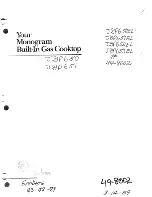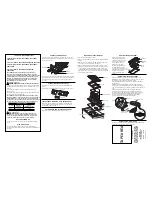
I
nstructions for the installer
Before connecting the appliance to the supply, check that
This appliance must be installed in a place with the
proper level of ventilation. The gases produced during
combustion must be released to the outside.
Check the size of the hob and the size of the opening to
be made on the kitchen unit.
The work surface must be level and horizontal. The
the cut-out has been made. The work surface must be
sealed with the wall to protect against damp.
If it is to be installed over an oven, you must check that
the oven is suffiently well ventilated and check the
dimensions as given in the installation manual.
The panelling on the work surface in the immediate
vicinity of the hob must be made of non-flammable
material. Both stratified coatings and the adhesive used
to fix them in place must be heat resistant. Otherwise,
they may be damaged.
Electric wiring must not come into contact with hot areas.
The mains supply cable must be fixed to the kitchen unit
to prevent it from coming into contact with hot parts on
the oven or hob.
Appliances with electric components must be earthed.
Handle the appliance with care throughout the entire
installation process. Avoid knocking the appliance.
This appliance shall be installed in accordance with the
regulations in force and only used in a well ventilated
location. Read the instructions before installing or
using this appliance.
SHOULD THE RELEVANT CONDITIONS NOT BE
PROPERLY SATISFIED, THE INSTALLER, AND NOT
THE MANUFACTURER, SHALL HELD LIABLE.
Installing the hob in the kitchen unit
The positioning of a hob in a kitchen unit is Class 3 according to the
The wood fibres used in the manufacture of kitchen work surfaces
are liable to swell when they come into contact with moisture. You
are recommended, therefore, to coat cut edges with a special
adhesive to protect them from steam or condensed water which
could deposit beneath the work surface on the kitchen unit.
The fixtures and the watertight seal (lower edge of the hob) come
factory-fitted. Do not under any circumstances remove them. The
seal keeps the entire work surface watertight and prevents
leakage.
Once the hob is fitted you should turn the clipand tighten the screw
as shown in Fig. 4. For disassembly, unscrew the clip and
proceed in the reverse manner.
1-Minimum Distances (mm). Cut a hole of the necessary
size in the work surface, Fig. 2.
Centre the hob in the hole on the work surface.
B- Flush installation method
Important note:
All cut-outs in the work surface are to be carried out at
a specialist workshop.
The cut must be clean and precise, since the cut edge
is visible on the surface. The stability of furniture being
worked on must be ensured following the cut-outs.
Use special heat and water-resistant work surface (e.g.
natural stone or tiled work surfaces).
See the diagram for the cutting dimensions. Fig. 2a.
The units into which the cooker is fitted must be heat-
On tiled worktops:
If necessary, raise the height of the surfaces by fitting heat
and water-resistant strips all the way round. Fig. 5
Place the hob horizontally into the cut-out and align it,
ensuring that the join is even on all sides, Fig. 4a. The hob
should be positioned just below the work surface.
1. Check the function and location of the appliances.
2. Fill in the gap between the worktop and the ceramic hob
using a suitable commercial silicone bonding agent in a
colour of your choice. Fig. 4b.
Caution. Use of unsuitable silicone bonding agents on
natural stone worktops can cause permanent
discoloration. Suitable bonding agents can be obtained
from our after-sales service, cod. 310818 (inox colour
C197).
Please observe the manufacturer´s instructions for use.
Apply the silicone bonding agent in the joints.
Before the silicone bonding agent stars to form a skin,
moisten a blade or your finger with a soapy solution and
smooth it over.
The hob should only be used once the silicone bonding
agent has hardened.
Please detach and keep
a distance of 10 mm. from the bottom of the
If no oven is installed under a gas hob, it is
hob to prevent access to the lower part of the
A- Normal installation method
hob.
suggested to
place a separator of non-flammable material e.g. plywood
or metal at
In the event that a drawer is located beneath
only.
the appliance,
please make sure that the drawer contains no
heat-sensitive or easily combustible objects, such as
spray cans or shoe polish. Use a heat-resistant utility drawer
en
an authorised installation engineer, respecting
of the gas and electricity providers.
conversion to other types of gas must be carried out by
All operations relating to installation, regulation and
applicable regulations, standards and the specifications
Assistance Service to convert to another type of gas.
and gas supply.
Before you begin, turn off the appliance' s electricity
indicated on the characteristics plate.
You are recommended to contact the Technical
Our hobs leave the factory set for the gas type
it is prepared for the type of gas in question (see table I).
stability of the work surface must still be guaranteed after
standard for gas appliances EN 30-1-1.
resistant up to 90 C.
°
Summary of Contents for CG270210
Page 3: ...5 FR FR FR 6 7 4a 4b 11 11 _0 _0...
Page 4: ...9 10 7 mm 8 11...
Page 31: ......
Page 32: ...Cod 9000169472 G...






































